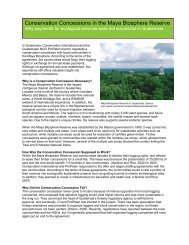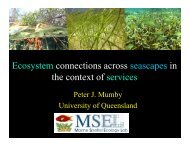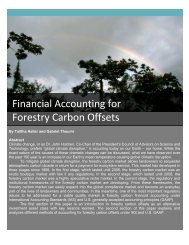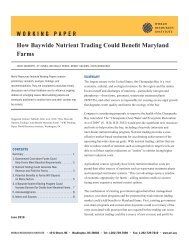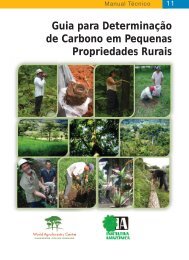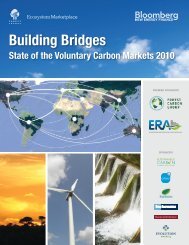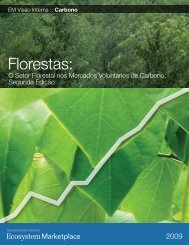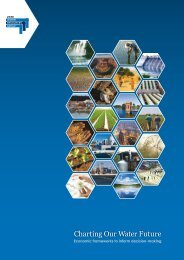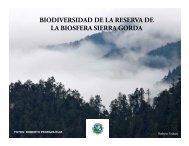Design of US Habitat Banking Systems to Support the Conservation ...
Design of US Habitat Banking Systems to Support the Conservation ...
Design of US Habitat Banking Systems to Support the Conservation ...
Create successful ePaper yourself
Turn your PDF publications into a flip-book with our unique Google optimized e-Paper software.
A DETAILED LOOK AT WETLAND AND CONSERVATION BANKINGThe o<strong>the</strong>r noteworthy aspect <strong>of</strong> <strong>the</strong> above definitionis that it clearly contemplates management <strong>of</strong> <strong>the</strong>land in a conservation bank. That is because manyendangered species require active management <strong>of</strong><strong>the</strong>ir habitats (e.g., prescribed burning, control <strong>of</strong>exotic vegetation, etc.) <strong>to</strong> ensure that those habitatsare <strong>to</strong> continue <strong>to</strong> be occupied by <strong>the</strong> species.That is, occupied endangered species habitat, if leftunmanaged, may cease <strong>to</strong> be occupied. For manyendangered species habitats, particularly thosedependent upon frequent fire or o<strong>the</strong>r disturbance,recurrent disturbance through active managementmay be a necessity. Long-term management <strong>of</strong> conservationbank sites thus becomes a vitally importantaspect <strong>of</strong> <strong>the</strong>se banks.Where <strong>the</strong> number <strong>of</strong> credits in a conservation bank isbased on <strong>the</strong> success <strong>of</strong> efforts <strong>to</strong> increase <strong>the</strong> population<strong>of</strong> <strong>the</strong> target species (as in <strong>the</strong> red-cockadedwoodpecker and Utah prairie dog banks discussedearlier), <strong>the</strong>re would not appear <strong>to</strong> be as much need<strong>to</strong> prescribe management requirements at <strong>the</strong> outset.Giving <strong>the</strong> banker in such situations <strong>the</strong> flexibility <strong>to</strong>pursue population goals with whatever managementmeasures he thinks are most likely <strong>to</strong> succeed makesabundant sense, since credits are only earned if thosemeasures succeed.Although, as noted above, <strong>the</strong> Service’s conservationbanking guidance requires that banks be protected inperpetuity, <strong>the</strong> Service has also been exploring somewhatanalogous, non-permanent banking arrangementsthat it calls “recovery credit systems.” The pro<strong>to</strong>typefor <strong>the</strong>se is an effort around Fort Hood army base inTexas that has been encouraged by <strong>the</strong> Service, butthat does not yet have its final blessing. This effortcontemplates <strong>the</strong> generation <strong>of</strong> credits from non-permanentconservation commitments made by nearbylandowners and <strong>the</strong> use <strong>of</strong> those credits <strong>to</strong> <strong>of</strong>fsetnon-permanent impacts <strong>of</strong> certain activities on FortHood. It also allows for <strong>the</strong> generation <strong>of</strong> credits frompermanent conservation commitments that can beused <strong>to</strong> compensate for permanent losses <strong>of</strong> habitat onFort Hood.The rationale for requiring permanent protection <strong>of</strong>wetland mitigation banks is that <strong>the</strong>y compensate forwetland losses that are virtually always permanent.Regulated impacts <strong>to</strong> endangered species habitats,however, do not always entail permanent loss <strong>of</strong>that habitat. Moreover, some endangered specieshabitats (e.g., for <strong>the</strong> black-capped vireo, Karnerblue butterfly, and bog turtle) are early successionalor transi<strong>to</strong>ry habitats, and thus, <strong>the</strong>y are, by <strong>the</strong>irvery nature, impermanent and are capable <strong>of</strong> beingrepeatedly recreated through natural (or managementinduced) disturbance. One <strong>of</strong> <strong>the</strong> peculiarities<strong>of</strong> <strong>the</strong> Endangered Species Act is that <strong>the</strong> legality orillegality <strong>of</strong> an action may turn on whe<strong>the</strong>r <strong>the</strong> habitatit affects is actually occupied by a listed speciesat <strong>the</strong> time <strong>of</strong> <strong>the</strong> action. Thus, an action that affectsan early successional habitat that is occupied, forexample, by <strong>the</strong> black-capped vireo, may require mitigationunder <strong>the</strong> Endangered Species Act, whereas<strong>the</strong> same action, if carried out in <strong>the</strong> same place adecade later after <strong>the</strong> habitat has matured and is nolonger occupied by <strong>the</strong> vireo, may not. Given that <strong>the</strong>effects <strong>of</strong> some regulated actions on endangered specieshabitats are impermanent, and that some endangeredspecies habitats are <strong>the</strong>mselves impermanent,<strong>the</strong> apparent willingness <strong>of</strong> <strong>the</strong> U.S. Fish and WildlifeService <strong>to</strong> reconsider its current requirement thatcredits available <strong>to</strong> compensate for impacts <strong>to</strong> endangeredspecies must be based on permanently protectedlands is understandable. An alternative approachthat has been utilized in California addresses temporaryimpacts by using “discounted” mitigation ratios,but still requires permanent protection <strong>of</strong> some habitat<strong>to</strong> <strong>of</strong>fset <strong>the</strong> temporal loss <strong>of</strong> o<strong>the</strong>r habitat.For now, however, <strong>the</strong> policy <strong>of</strong> <strong>the</strong> Service is thatlands included in conservation banks must be protectedin perpetuity through some legally bindingmechanism. For state wildlife action plans that seek<strong>to</strong> secure high priority areas for permanent protection,conservation banking thus <strong>of</strong>fers a mechanism t<strong>of</strong>ur<strong>the</strong>r that objective that is ultimately funded by <strong>the</strong>proponents <strong>of</strong> development projects that detrimentallyaffect similar, but less critically important, habitatselsewhere.Balancing <strong>Conservation</strong> and Economic Objectives:Establishing Bank Service AreasWetland Mitigation BanksA bank’s service area is “<strong>the</strong> designated area (e.g.,watershed, county) wherein a bank can reasonablybe expected <strong>to</strong> provide appropriate compensation for<strong>Design</strong> <strong>of</strong> U.S. <strong>Habitat</strong> <strong>Banking</strong> <strong>Systems</strong> <strong>to</strong> <strong>Support</strong> <strong>the</strong> <strong>Conservation</strong> <strong>of</strong> Wildlife <strong>Habitat</strong> and At-Risk Species 53



